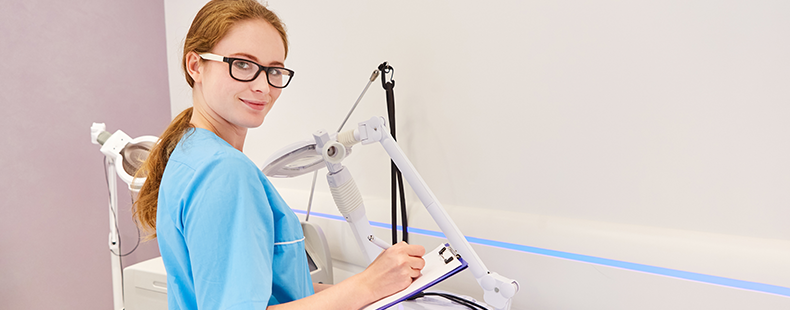If you're passionate about skincare, beauty, and helping people feel their best, a career as an aesthetic nurse might be your perfect fit! With the global medical aesthetics market projected to reach $25.9 billion by 2028, the demand for skilled professionals in this field is skyrocketing. These specialized nurses blend medical expertise with cosmetic artistry, assisting with treatments like Botox, dermal fillers, and laser procedures.
With the demand for non-surgical cosmetic enhancements soaring, it's an exciting and rewarding field to enter. But how do you get started? Read our guide to learn more about the education, training, and certifications needed to become an aesthetic nurse, plus insider tips on excelling in this fast-growing industry. So, how to become an aesthetic nurse, and what does this career involve? Let’s explore.
What is an Aesthetic Nurse?
An aesthetic nurse, also known as a cosmetic nurse, is a registered nurse (RN) or nurse practitioner (NP) specializing in non-surgical cosmetic procedures. These specialists work in medical spas, dermatology sanitariums, or plastic surgery offices. They help their clients improve their looks via various treatments, such as microneedling, chemical peels, etc.
Aesthetic nurses assess patients, develop treatment plans, and administer procedures under a physician’s supervision. Unlike customary nursing positions, their priority is on improving attractiveness, uplifting confidence, and preserving youthful skin.
To become an aesthetic nurse, one must complete nursing education, obtain an RN license, gain clinical experience, and receive specialized training in cosmetic procedures.
Read More: How To Become a Pediatric Registered Nurse?
What Are The Major Types of Aesthetic Nurses?
Aesthetic nurses can be registered nurses or nurse practitioners. Below are the major types of aesthetic nurses and the unique roles they fulfill in this exciting profession.
1. Injectables Nurse
These nurses specialize in administering cosmetic injectables such as Botox, dermal fillers, and PRP (platelet-rich plasma) treatments. They help patients achieve a youthful appearance by reducing wrinkles, restoring volume, and enhancing facial contours.
2. Laser Treatment Nurse
Laser nurses operate advanced laser and light-based devices to perform skin resurfacing, hair removal, tattoo removal, and treatments for pigmentation issues. They require specialized training in laser safety and technology to ensure effective results.
3. Plastic Surgery Nurse
Working alongside plastic surgeons, these nurses assist in both surgical and non-surgical aesthetic procedures. They prepare patients for surgery, assist during operations, and provide post-operative care to ensure optimal recovery.
4. Medical Spa (Med Spa) Nurse
Med Spa nurses work in medical aesthetics clinics, offering a variety of non-invasive treatments, including chemical peels, microneedling, and skin rejuvenation therapies. They focus on enhancing skin health and appearance while providing a luxurious patient experience.
5. Dermatology Aesthetic Nurse
These nurses specialize in cosmetic dermatology, working closely with dermatologists to treat conditions such as acne, scarring, rosacea, and aging skin. They may assist with advanced treatments like radiofrequency therapy, microneedling, and PRP facials.
6. Surgical Recovery Nurse
Post-operative aesthetic nurses care for patients recovering from cosmetic procedures like facelifts, liposuction, or breast augmentations. They monitor healing, provide pain management, and educate patients on post-surgical care.
Read More: The Importance of Continuing Education for Registered Nurses
How To Become an Aesthetic Nurse?
According to the U.S. Bureau of Labor Statistics (BLS) 2023 report, the average salary for an aesthetic nurse in the United States is $80,321 per year or $39 per hour. In comparison, the median salary for all nurses is $86,070 per year or $41.38 per hour.
The demand for aesthetic procedures is increasing. Thus, this makes aesthetic nursing a stable and growing career. So, let’s learn how to become aesthetic nurse by following the steps below:
Read More: How to Become a Registered Nurse: A Step-by-Step Guide
Step 1: Earn a Nursing Degree
The first step to becoming an aesthetic nurse is to become a registered nurse (RN). To do this, one must complete a nursing degree. There are two main options available. The first option to learn how to become an aesthetic nurse is an Associate Degree in Nursing (ADN), which takes about two years. The program provides the basic knowledge and skills needed to become an RN.
The second option is a Bachelor of Science in Nursing (BSN), which takes about four years. Most employers prefer a BSN because it provides more in-depth training, leadership skills, and career advancement opportunities. Many healthcare facilities require nurses to have a BSN for specialized roles, including aesthetic nursing.
Step 2: Pass the NCLEX-RN Exam
After completing a nursing degree, the next step is to pass the National Council Licensure Examination for Registered Nurses (NCLEX-RN). The exam tests the candidate’s nursing knowledge, problem-solving abilities, and decision-making skills.
The test covers various topics, such as patient care, safety procedures, and healthcare ethics. Moreover, passing this exam is necessary to obtain a nursing license. Without a license, one cannot work as an RN. Each state has its own licensing requirements, so it is important to check with the state’s nursing board to complete the process.
Step 3: Get Nursing Experience
Most aesthetic nursing jobs require nurses to have prior experience in general nursing before they can specialize in aesthetic procedures. Many aesthetic nurses start their careers in areas like dermatology, plastic surgery, intensive care, or emergency medicine.
Working in these fields helps nurses gain knowledge about skin health, wound healing, and medical procedures, which are important in aesthetic nursing. Moreover, it improves their ability to handle patients with different medical histories and conditions. Some employers may require at least two years of nursing experience before allowing nurses to perform cosmetic procedures.
Step 4: Get Certified in Aesthetic Nursing
Although certification is not mandatory, it can help nurses stand out in the job market. Certification proves that a nurse has specialized knowledge and skills in aesthetic procedures.
The Certified Aesthetic Nurse Specialist (CANS) certification is one of the most recognized credentials in this field. It is also offered by the Plastic Surgical Nursing Certification Board (PSNCB) and requires candidates to have at least two to three years of experience in aesthetic nursing.
Another well-known certification is the Certified Plastic Surgical Nurse (CPSN), which the PSNCB also provides. Having a certification can increase job opportunities by improving credibility and allowing nurses to perform more advanced cosmetic treatments.
Step 5: Gain Hands-On Training in Aesthetic Procedures
Aesthetic nurses must learn how to perform cosmetic procedures safely and effectively. These procedures include Botox injections, dermal fillers, laser treatments, chemical peels, and microneedling. Each of these treatments requires specific techniques and a deep understanding of how they affect the skin and underlying tissues.
To gain hands-on training, nurses can attend workshops, online courses, and mentorship programs. Some aesthetic nurses train under-experienced professionals in medical spas or dermatology clinics. Many clinics prefer hiring nurses who have completed hands-on training programs since these nurses require less supervision and can start working immediately.
Step 6: Apply for Aesthetic Nursing Jobs
Once a nurse has obtained the necessary experience, training, and certifications, they can start applying for aesthetic nursing positions.
Aesthetic nurses work in various healthcare settings, including medical spas, dermatology clinics, plastic surgery offices, and wellness centers. Some nurses also work in hospitals, especially in departments that handle reconstructive or cosmetic surgery.
When applying for jobs, it is important to have a strong resume highlighting nursing experience, certifications, and hands-on training. Employers often prefer candidates who have experience in cosmetic treatments and a background in patient care. Networking with professionals in the field and joining aesthetic nursing organizations can also help nurses find job opportunities.
Step 7: Consider Advanced Education
Although not required, some aesthetic nurses choose to advance their careers by pursuing higher continuing education for nurses. Becoming a nurse practitioner (NP) through a Master of Science in Nursing (MSN) program allows nurses to perform more advanced procedures, prescribe medications, and even open their own clinics. This can lead to greater independence and higher earning potential.
Advanced education can also provide deeper knowledge in areas such as dermatology, skin care treatments, and aesthetic medicine. Some nurse practitioners specialize in cosmetic dermatology, which allows them to perform complex aesthetic procedures and provide consultations on skin health.
What are the Responsibilities of Aesthetic Nurses?
Aesthetic nurses specialise in non-surgical cosmetic procedures, helping clients enhance their appearance while ensuring safety and effectiveness. They work in medical spas, dermatology clinics, and plastic surgery centres. Their responsibilities vary based on their specialization, but common duties include:
Conduct patient consultations to assess skin concerns, medical history, and aesthetic goals.
Administer Botox, dermal fillers, and other cosmetic injectables.
Perform laser treatments, microneedling, chemical peels, and PRP therapy.
Assist in pre- and post-operative care for plastic surgery patients.
Educate patients on treatment options, risks, and expected results.
Monitor patients for adverse reactions and manage complications.
Follow infection control protocols and ensure regulatory compliance.
Develop personalized treatment plans and provide post-care instructions.
Operate and maintain aesthetic equipment and tools.
Stay updated on new aesthetic techniques and industry advancements.
Maintain patient records and ensure confidentiality.
Provide excellent customer service to enhance the patient experience.
Aesthetic Nurse Salaries by State (2025)
The salary of an aesthetic nurse varies based on location, experience, and certifications. Below is a state-wise breakdown of average salaries:
State | Hourly | Weekly | Monthly | Annual |
Alabama | $36.23 | $1,449 | $6,280 | $75,350 |
Alaska | $55.93 | $2,237 | $9,700 | $116,340 |
Arizona | $46.96 | $1,878 | $8,140 | $97,680 |
Arkansas | $36.02 | $1,441 | $6,240 | $74,920 |
California | $72.19 | $2,888 | $12,510 | $150,160 |
Colorado | $46.88 | $1,875 | $8,130 | $97,510 |
Connecticut | $51.03 | $2,041 | $8,850 | $106,150 |
Read More: What is the Registered Nurse Salary in the USA
Skills Needed for an Aesthetic Nurse
Aesthetic nursing requires both medical knowledge and strong patient care skills. Nurses in this field must be precise, detail-oriented, and able to communicate well with patients. So, once you know how to become an aesthetic nurse, here are the important skills needed to succeed as an aesthetic nurse.
Attention to Detail
Nurses must carefully inject fillers, use lasers, and perform skin treatments. Even a small mistake can affect a patient’s appearance. They must follow hygiene rules to prevent infections and understand facial structure and skin types for the best results.
Communication Skills
Nurses must explain procedures clearly and help patients feel less nervous. They should describe the benefits, risks, and aftercare steps. Listening to patients’ concerns builds trust and improves results.
Steady Hands
Aesthetic procedures require careful hand control. Botox, fillers, and laser treatments need precise movements to avoid mistakes. Experience and practice improve accuracy.
Patient Care
Nurses must check a patient’s medical history to avoid problems. They should watch for side effects and give proper care if needed. Clear aftercare instructions help prevent infections and ensure healing. Good patient care builds trust.
Read More: What are the Important Requirements for RN Continuing Education?
Building a Successful Career in Aesthetic Nursing!
Aesthetic nursing is a rewarding career that blends medical skills with cosmetic treatments. To succeed as an aesthetic nurse, you should know how to become an aesthetic nurse by completing the right education, gaining hands-on experience, and obtaining certifications. Start by earning a nursing degree (RN or BSN) and obtaining your registered nurse license. Gain experience in a relevant field like dermatology or plastic surgery, then pursue specialized training in aesthetic procedures. Certifications, such as the Certified Aesthetic Nurse Specialist (CANS), can further enhance credibility and career prospects. Networking, staying updated on the latest trends, and refining injection skills are also key to long-term success.
For those looking to expand their scope of practice, enrolling in a Nurse Practitioner (NP) course opens doors to advanced procedures, independent practice, and leadership roles in medical aesthetics.
References:





































.webp)
.webp)












